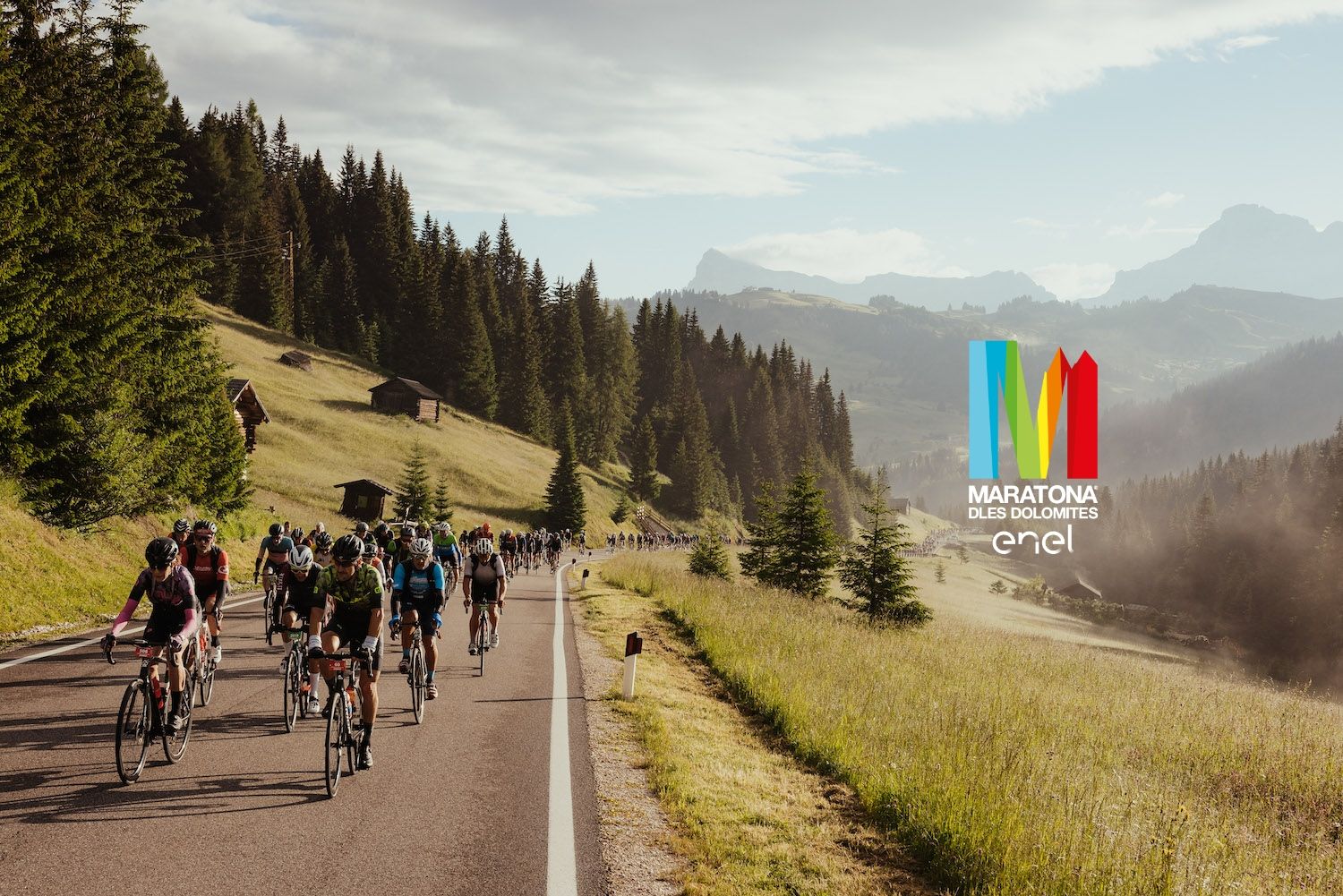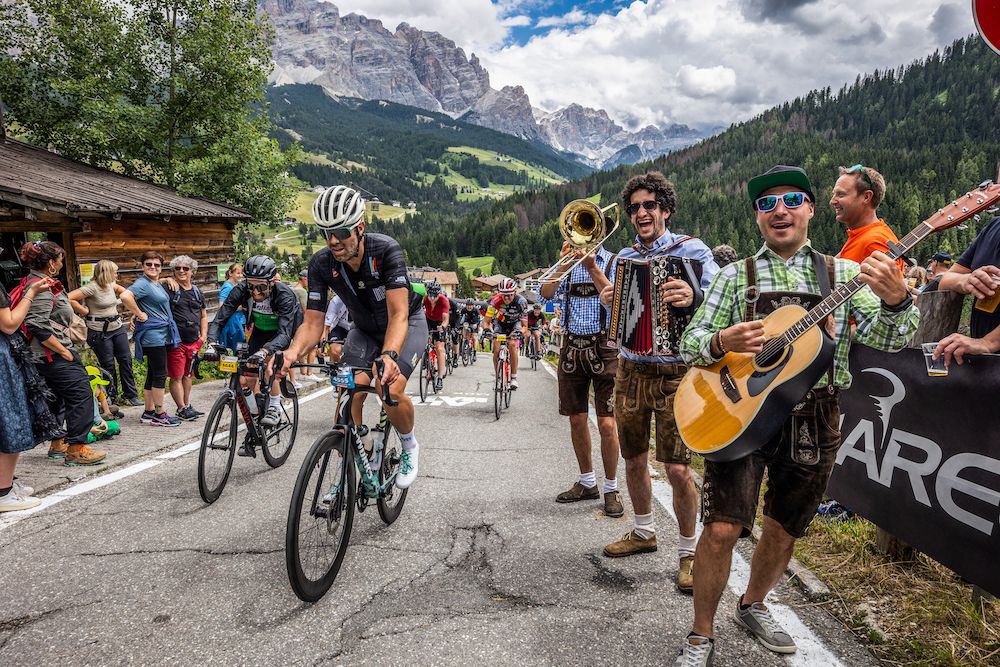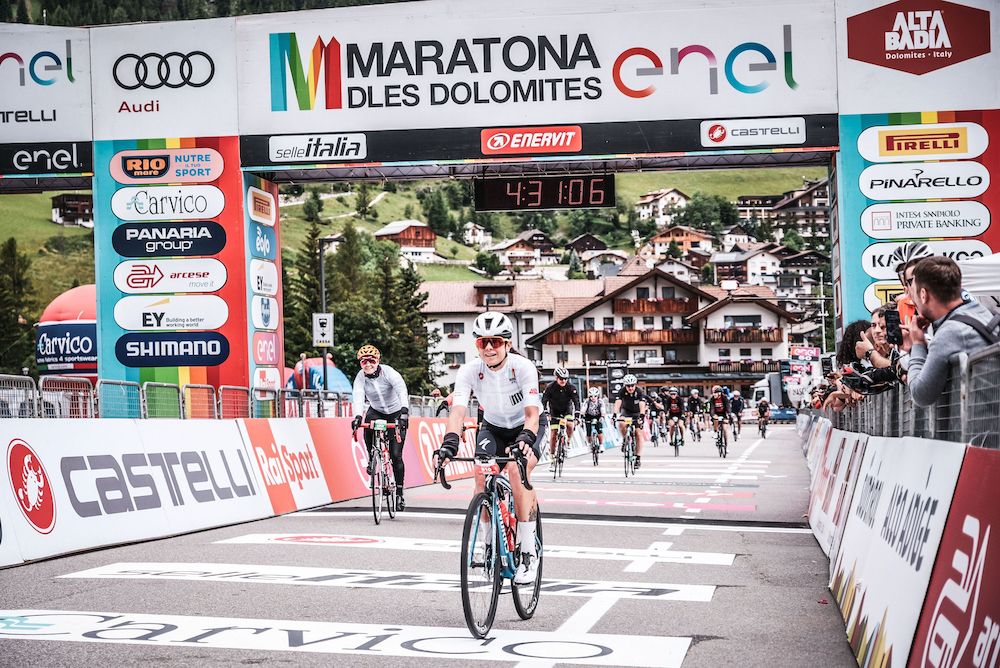
Maratona dles Dolomites: The Indescribable Allure of the World’s Most Stunning Gran Fondo
Captivating, magnificent, breathtaking, fun, grueling, overwhelming, jaw-dropping are but a small sampling of words that have been used to describe Italy’s most incomparable amateur cycling event. Welcome to the Maratona dles Dolomites.
The name may not resonate with some but mention of the Dolomites alone is enough to make this gran fondo one of the most prized of any cyclist’s life list. Top that off with the entire 138km of race routes being closed to all vehicular traffic and it qualifies as a “must do” for anyone relishing a spectacular two-wheeled challenge.
This region of the Alps of northeast Italy exudes unmatched natural beauty and, those in the know agree that there’s little doubt, the Maratona is the most jaw droppingly scenic of granfondos anywhere.
It’s appropriate that the most majestic of granfondos takes place in Italy where this most passionate and cycling-crazed of nations first created these “big ride” events in 1970.
A Little History of the climbs and race route of the Maratona ‘Big Ride’
The Maratona has grown in popularity and prestige each year since it was created. In 1982, the founder of the local Alta Badia Cycling Club (whose son is now involved in carrying on the tradition of the Maratona) decided he wanted to host a bigger event reminiscent of Europe’s longer cross-country ski marathons and thus, the Maratona dles Dolomites was born. Those 166 first participants tackled the only route offered that year: 157km with over 5000 meters of elevation gain. Imagine that on 1980s gearing!
From humble beginnings, the Maratona dles Dolomites has become one of the most important and sought after amateur cycling events in the world . The number of race (ride for most) participants has grown dramatically since the event’s inception in 1982, to the point where entry is now limited and on a lottery basis. Of the 27,000 lottery entrants in 2023, fewer than 8,000 were accepted into the event. 73 different nations were represented and 11% of the riders were women, a category that grows exponentially each year. The limited entries are aimed at maintaining the quality of the event and not overwhelming the area, all while connecting participants with the natural beauty of the region, which has a strong ecological ethos. Organic, biodynamic, Slow Foods, and local mountain products factor strongly in the mission outlined by the UNESCO World Heritage guidelines since the Dolomites were officially recognized by the organization in 2009.
Eventually, if your lottery number doesn’t come up during your first five years of attempts, you’re guaranteed entry after that. However, there’s an easier way to acquire a race bib (entry). Join a trip with an Official Maratona dles Dolomites – Enel Tour Operator, such as CyclingHero , and you’re guaranteed entry and convenient accommodations just steps from the finish in the mountain village of Corvara – “ride central.”
The Maratona course: The Sellaronda et al
There are now three routes that vary in distance and elevation gain. The Sellaronda is the shortest at 55km and 1780 meters of climbing while the full Maratona route is 138km and includes 4230 meters of climbing. Shortly before reaching the point of no return for the full Maratona route, there’s the option to pull the ripcord and opt for the medium route that bypasses the toughest climb up the formidable Passo Giau , which features a steady 10% grade for 10km.

The Maratona may not be the toughest gran fondo in Europe but the challenge is undeniably real . The route climbs and descends repeatedly, with no perceptible level terrain, and is a true climber’s event.
Of the seven passes included in the full Maratona route, the Passo Pordoi may be one of the most famous due to its beauty, history, and frequent inclusion in the Giro d’Italia. Each of the three route options climb the Passo Pordoi, where a monument to the great Italian cycling legend, Fausto Coppi , keeps watch over the pass. As a domestique at the age of 20, the famed racer first cut his teeth on, and ended up winning, his first Giro title on a snowy day on the Pordoi in 1940. He later joined the Italian Army to fight against the Allies in WWII, eventually becoming a prisoner of war.
Other notable climbs that you will encounter are the Campolongo Pass, the Passo Sella, the Passo Valparola, and the Passo Gardena. Make sure you don't burn all your matches and have something left in the legs for the short but nasty Mür dl Giat shortly before the finish line of the medium and long option.
Mountain Passes & South Tyrol Folk
The region gained historical significance during WWI as Italian and Austrian troops battled over bordering territory in the mountains. Austria had controlled the region for centuries before the Italians drove them out in 1918. This resulted in distinguishing the region as culturally quite different from the rest of Italy as many of the Dolomite region villages have a more Austrian feel to them than Italian. The blend of these two cultures is evident in many villages where German often remains the primary language. This area is also the ancestral home to a unique culture, the Ladin , that managed to survive both World Wars.
The Ladin have lived in the hills and pastures in the shadow of the Dolomites for centuries, and have retained their own language, which is the third official language in the region along with Italian and German. As a culture, the Ladin remain highly respectful of the natural world and the beauty that surrounds them, and are deeply passionate about the preservation of their heritage.

These welcoming and friendly mountain folk seem to lead the action when it comes to local support for the Maratona. Not only do they provide traditional homemade cakes, tarts, and local meats for some of the feed stations, they turn out in droves to swell the ranks of loudly cheering spectators lining the route.
In keeping with the Ladin reverence for preservation of the natural world that surrounds them, since 2019 “ The Maratona dles Dolomites – Enel has been awarded ‘ Green Event ’ status, thanks to its numerous initiatives to manage resources in the best way possible and its measures to reduce excessive energy consumption. The theme of sustainability has always been at the heart of the Maratona, and because the word sustainability means something concrete to us, each year we try to add a new element to make the event more ecological and less harmful to the environment. ”
The ride has become so popular that it appears anyone living within striking distance of the event seems to find a way to volunteer or simply join in the festivities. Boisterous and supportive crowds, some in traditional Tyrolean garb , line the course cheering riders on, particularly up the tougher climbs, of which there are plenty. Lively bands playing traditional regional music, which echoes across the landscape, is interrupted by the deep drone of amazingly long alpine horns and a cacophony of cow bells being rung at a ferocious pace. This atmosphere is as close as one might get to the feeling of riding in a top international race.
Paolo Bettini , the elite international Italian ex-pro, has ridden the Maratona for 13 years and describes it as the “event of events.” He goes on to say that this gran fondo is “ an epic, closed-road event over climbs where some of the greatest cyclists in history have ridden. ” It’s also an event that welcomes mere mortals who vie for an elusive start bib (required for entry into the event) granting the opportunity to experience the challenge and intrigue of tackling its famous passes and serious elevation gain.
Bettini describes a “ deep sense of unity and humanity ” among the participants and “ a shared passion for cycling – the bond that unites us .” His words ring true among riders and spectators alike as all are caught up in the celebratory enthusiasm of this annual event day. While small talk may be at a minimum as riders huff and puff their way up the climbs, the mutual admiration between them is evident.
Rock of Ages- The Pale Mountains of the Dolomites
Regardless of results, the natural beauty that sets the stage for the ride is the true star of the event. The Dolomites are perhaps the most magnificent and unique collection of mountain landscapes in the world, and the entire region that encompasses them was named a UNESCO World Heritage Site for that very reason. The 18 peaks that comprise the range all rise above 10,000 feet and sprawl over a region of nearly 550 square miles. While the towering peaks draw much of the attention, it’s the combination of verdant hillside pastures and long narrow valleys in tandem with those peaks that make for unusually dramatic views.
The seemingly endless procession of towering peaks, sheer rock cliffs, and needle-like spires of the Dolomites create an alpine scene like no other. The Pale Mountains , as the Dolomites are often called, are composed of volcanic rock, limestone, and dolomitic rock that is typically formed in warm, shallow marine basins. The stunning mountains bearing the rock’s name are the most striking and expansive form of visible dolomite on the planet.
The Dolomites were formed, along with the other European Alps, somewhere between 60 and 5 million years ago when the African Continent pushed north into the European Continent and forced deep layers of marine sediment, containing calcium carbonate rich shells and corals, to pile up on top of one another. As the layers were pushed higher, dolomitic rock was formed. It is not uncommon to find marine fossils in the Dolomites that date to some 250 million years ago, a time when over 90% of all marine species perished and dinosaurs began to evolve. Dinosaur footprints have even been discovered in the dolomitic rock of several locations within these mountains.
Ice, wind, and water have polished the exposed rock of the Dolomites into glistening icons in recent centuries. During the summer months, the peaks transform into glowing hues of rose pink and then purple as the sun begins to sink lower in the sky each afternoon. This phenomenon is referred to by the Ladins as “ enrosadira ” which translates literally into “ become rose-colored .” This transformation is due to the unique calcium carbonate and magnesium component of the rock. If you lift your head later in the day, from counting the revolutions of your front wheel or your pedal strokes as you’re climbing the final pass, you will hopefully bear witness to this magical transformation.
From the Saddle
With the omnipresent Dolomites looming around you, race day begins early to allow a ten-hour window for cyclists to finish the full ride. A chill mist often blankets the valley at this early hour as riders assemble and jockey for a place near the front of their designated pen. The fresh mountain air is infused with the scent of evergreen trees and the aroma of coffee. It’s well worth having someone hang onto your bike to pop out of line for some extra calories from fresh-baked strudel. The building excitement and energy among riders is palpable, even at such an early hour, as race helicopters circle overhead and the coffee consumption amps up conversation between participants from across the globe.

Once the race begins, the lead group of ex-pros and top amateurs speed off and the remainder of the 7000 plus cyclists begin their slow climb up the Passo Campolongo and then the Passo Pordoi, as the huge throng begins to spread out over the first 25 to 30 kilometers. The top riders leading the race/ride will finish the full route in slightly over four hours as many of the remainder of the pack struggle to make the 11:45am cutoff mark for the long option, following which the route option decision is made for you and you. While some find relief in this, others are disappointed to lose their chance at the most challenging climb, over the Passo Giau.
After the main event
Whichever route you choose (or is chosen for you!), the post-ride festivities , food, and drink bring riders together in a celebration worthy of Oktoberfest. Replenish your depleted energy level as you rub elbows with famous ex-pros, eat, laugh, and regale friends new and old, with tales from the event – all while surrounded by the shared glow of accomplishment and reverie of 8000 fellow cyclists.
Two-time women’s division Maratona dles Maratona – Enel winner, Martha Maltha of the Netherlands had this to say about the event after finishing 2nd in 2023: " This remains absolutely my favorite gran fondo of the ones I've ridden. The bizarrely beautiful surroundings, the atmosphere all week in Corvara… I would say everyone should have ridden this one once. ”
No matter your finishing time or the course you rode, you’ll surely never forget your, perhaps, once-in-a-lifetime experience riding the Maratona dles Dolomites , the most magnificent and alluring gran fondo on earth .
Get to the start of the Maratona dles Dolomites-Enel
A few practicalities: the easiest place to fly into is Venice Marco Polo Airport. We pick you up from the airport or nearby Venice or Treviso.
As an official tour operator for the Maratona, your entry is guaranteed. You simply need to ride down to the maratona village and pick up your race pack.
Booking is straightforward. You have multiple hotel options to choose from.
#mdd #cyclinghero #granfondo #Italycyclingevents #Dolomitescyclingevents #Dolomitescyclingtrips